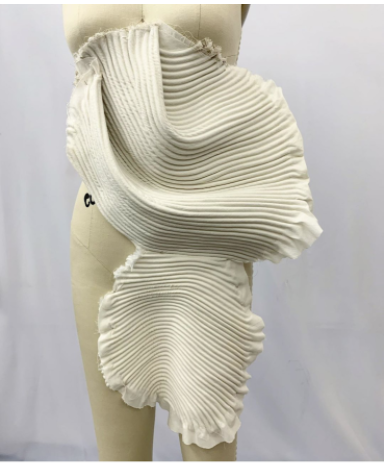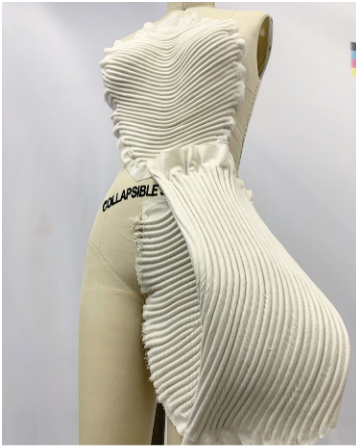Faces + Spaces: Lily Barnes
Sitting on a curved metal bench, nestled between towering plants in her aunt’s garden, fashion design student Lily Barnes preps her schedule for the week. She puts down her .3 mm black ink Micron pen to check her phone, finding herself lost in new recipes to cook that week. Potatoes are her current mood. She finds a recipe for roasted garlic, buttery parmesan potatoes. Then her mind flips back to her stress, namely the search for her senior thesis topic. She asks herself, “what’s important to me? What experience has changed me?” She thinks, “I care about potatoes … but those aren’t meaningful.”
Barnes looks down and picks up a crumbled leaf. As she smooths it out, running it through her long fingers, she gets lost in its almost perfect symmetry yet slight fluctuations. She stares at how the leaf is broken up by its many lines, its consistency in some places and sporadic forms in others. She flips it over to see its veins, and suddenly she remembers, this leaf is alive. She enters a trance as the leaf mesmerizes her.
A senior at the Rhode Island School of Design, Barnes will be working this academic year on her senior thesis, a collection of six to seven outfits she designs under a common theme and manifesto. Over the summer, her professor tasked her with journaling every day so she could discover her point of inquisition for her collection. Vulnerability comes to mind when Barnes reflects upon the process. Visual culture is inherently judgmental, not to mention that fashion is rooted in so many subconscious beliefs on beauty, on good and bad, she said. Barnes struggled on how she would manifest her persona and world outlook in her designs because of her anticipation that via the collection, she will be put on display for others to criticize.
Working each summer day in her aunt’s garden in the suburbs of Philadelphia, Barnes confronted her diagnosed attention deficit hyperactivity disorder, known as ADHD.
“My brain can’t shut up,” she said. “And the entire world right now is filled with anxiety and hypersensitivity. Social media and our technology add distraction and stress. I just got an iPad and I’m so fascinated by all the tools it has for my work, but we think [technology] is so cool, like ‘oo this new gadget’ but it’s just a distraction.”
Especially now, with eyes constantly on social media and the news due to COVID, the election and increasing social activism, there’s an overload of information to engage with. Barnes noticed that she, and others, continually entrench themselves in the many man-made stimuli. Now it’s more important than ever to find how to take a break from society’s chaos, and find the spectacular in what’s right in front of us.
“We have redefined earth with ourselves at the center,” she said, “What we put out for the world distracts us, not what the world puts out for us.”
Just as Barnes gets lost in her thoughts, she found herself getting lost in the flora and fauna surrounding her during her journaling sessions. From bugs to butterflies, hibiscus and lavender, her experience in the garden prompted the basis of her collection. While she does not have an overarching name for her work, Barnes plans to focus on the unappreciated beauty of nature.
When Barnes scrutinizes the minute aspects of nature she feels transported into an unimaginable setting, she said. Unlike most people, she said, Barnes fixates on the life and inner workings behind the colors, scents and shapes of plants.
Her work will not be floral and romantic. Her vision does not evoke flower’s colors and the shapes of plants. It’s not supposed to be obvious but rather a visual representation of the way Barnes’ mind organizes information and interacts with nature. The collection looks deeper, to the microscopic level, questioning the abstraction of the cells and patterns that give life to organisms. Barnes gets lost in nature’s beauty, glimpsing signs of magic in the way so many small particles build up to create something functional and beautiful that does not rely on human control.
The beginning of Barnes’ drapings. Images via Lily Barnes
“What I like so much about these small elements, like a vein in a random leaf, is that if you look up close and think about it closely, it’s crazy how mathematical and organized it is,” she said. “As I zoom in, I see it as if I’m entering this other world. Our society is so jaded to earth at this point that these earthly things almost become alien to us.”
Much of Barnes’ previous work also had a theme of repetition and detail merging to create a larger image. Thinking mathematically behind her aesthetics always served as a way to organize her thoughts.
“It’s therapeutic for me,” she said.
Her roommate Lily Durbin, also a senior studying apparel design, describes Barnes’ past work and collection idea as “labor intensive and detail-oriented.”
“In her past work, whether her garments were adorned by the collection of beach stones into specific pockets, or pants created from tiny squares sewn together, [she] examines how details can be gathered into a larger form through a repetitive, soothing motion,” Durbin said.
Her thesis is more than just the outfits though. She must design a story and aesthetic experience with makeup, hair, and the setting for her photographs and video of the collection. Since her concept lies in abstraction and she is unsure how she will share the collection in a non-literal way.
“You have to trust yourself but it's hard,” she said. “You need to work through the critiques, which just keep coming.”
Kylin Conant, a fellow senior in the apparel design program, admires how Barnes’s approach sees beyond the naked eye.
“Lily’s work reflects the articulation of nature in a way that’s not romantic or soft, but confident and assertive,” Conant said. “She mimics the fine, microscopic qualities that every living plant or thing has.”
Two of Barnes’ current “doodles,” as she calls them, guide her creative journey for her apparel designs. She begins to exhibit her interpretation of nature, using an ultraviolet induced visible fluorescence technique in these works for color inspiration.
While the work revolves around nature, she does not have an environmentalist approach to the collection. That’s not to say though she doesn't pay attention to sustainability as a fashion design student. She notes how fashion can achieve sustainability beyond biodegradable fabrics. Barnes hopes to use the extra fabric sitting around that would otherwise be burned or thrown out to use in her collection.
“I need to be careful with my scraps and excess as well as get stuff that’s just laying around from other places,” she said. “It’s crazy how much fabric is wasted.”
While it sounds tacky and cheesy, she said, returning to nature keeps her grounded. It blows her mind how little people think or care about the details of nature, the life and science that lives behind what we take for granted. The reverie of nature can be more than just a distraction, but a manner of reorienting our perspective in our hectic, screen modulated lives. Getting lost in our thoughts opens up new doors and ways of looking. For Barnes, daydreaming over the leaves around her actually ground her in the present, not some mythical dream.
Currently, Barnes’ is preparing for her muslin critique, when her instructors evaluate the construction of Barnes’ fabric ideas and patterns. This semester she will focus on three out of her six or so pieces. Her journey exploring the secret garden of her mind and nature has a long way to go.




